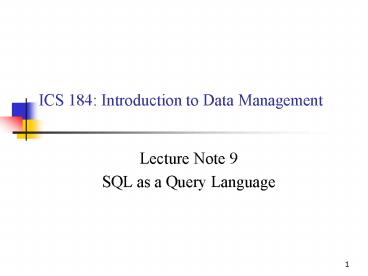ICS 184: Introduction to Data Management - PowerPoint PPT Presentation
1 / 14
Title:
ICS 184: Introduction to Data Management
Description:
Lecture Note 9 SQL as a Query Language SQL as a Query Language Insertion of a query s result INSERT INTO relation (query); CREATE TABLE LowIncomeEmp(ename char(12 ... – PowerPoint PPT presentation
Number of Views:50
Avg rating:3.0/5.0
Title: ICS 184: Introduction to Data Management
1
ICS 184 Introduction to Data Management
- Lecture Note 9
- SQL as a Query Language
2
SQL as a Query Language
- SELECT A1, A2, , An FROM R1, R2, , Rm
- WHERE conditions
- Example Emp(ename, dno, sal),
- Dept(dno, dname, mgr)
- Query 1 Find employees working in department
132. - SELECT ename
- FROM Emp
- WHERE dno132
- Query 2 Find the manager of the sells
department. - SELECT mgr
- FROM Dept
- WHERE dname sells
3
Insertion of a querys result
- INSERT INTO relation (query)
- CREATE TABLE LowIncomeEmp(ename char(12),
- dno int,
- sal float)
- INSERT INTO LowIncomeEmp
- ( SELECT
- FROM emp
- WHERE sal lt 30K AND dno 123
- )
- INSERT INTO LowIncomeEmp
- ( SELECT ename, dno, sal 1.1 ? salary
increased by 10 - FROM emp
- WHERE sal lt 30K AND dno 123
- )
- Note the order of querying and inserting query
first.
4
SQL vs relational algebra
- SELECT A1, A2, , An FROM R1, R2, , Rm
- WHERE conditions
- Equivalent relational algebra expression
- ?A1,,An (s cond (R1 ? R2 ? Rm))
- Difference
- Relational algebra uses set semantics
- Most SQL operators uses bag semantics
- However, SQL set operators use set semantics
5
Select clause
- Specify attributes to project onto (different
from the selection operator in the relational
algebra) - Can use relation prefix (especially when we need
to disambiguate attribute names) - Use star to denote all attributes
- SELECT
- FROM Emp, Dept
- WHERE Emp.dno Dept.dno
Dept(dno, dname, mgr)
Emp (ename, dno, sal)
6
Eliminate duplicates
- SELECT does not automatically eliminate
duplicates. - Select dno
- From Emp
- If there are more than 1 employee in the
department 333, then 333 will appear more than
once in the result. - Use keyword distinct to explicitly remove
duplicates - Select distinct dno
- From Emp
Emp (ename, dno, sal)
7
FROM clause
- Specify relations
- Renaming relations
- Use as to define tuple variables, to
disambiguate multiple references to the same
relation - who makes has higher salary than their manager
- SELECT E1.ename
- FROM Emp as E1, Dept, Emp as E2
- WHERE E1.dno Dept.dno AND
- Dept.mgr E2.ename AND E1.sal gt
E2.sal
E1 Emp (ename, dno, sal)
Dept(dno, dname, mgr)
E2 Emp (ename, dno, sal)
8
WHERE clause
- Specify conditions
- Optional
- Complicated conditions
- AND, OR, NOT,
- Employees who work for Sally and have a salary lt
10K - SELECT ename
- FROM Emp, Dept
- WHERE Emp.dnoDept.dno AND D.mgr Sally
AND sal lt 10000 - String patterns
- s LIKE p string s in pattern p
- Percent zero, one, or multiple occurrences of
any character - dname LIKE TOM
- TOM KERRY, TOM JOHNSON
- underbar _ one-character wildcard
- dname LIKE a _ c
- abc adc azc a9c
9
Conditions in a WHERE clause
- attribute names of the relation(s) used in the
FROM. - comparison operators , ltgt, lt, gt, lt, gt
- arithmetic operations stockprice2
- operations on strings (e.g., for
concatenation). - lexicographic order on strings.
- pattern matching s LIKE p
- special operations for comparing dates and times.
- Use relation prefix to disambiguate attribute
names - SELECT ename, dname, dept.dno
- FROM Emp, Dept
- WHERE Emp.dno Dept.dno
10
Ordering output tuples
Descending
- select
- from Emp
- order by dno, sal desc, ename
- Order the tuples by dno. Within each dept, order
salaries from highest to lowest. For salary ties,
use alphabetical order on the name. - ename dno sal location
- Mary 1 30K Irvine
- Susan 1 30K Irvine
- Jane 1 19K Irvine
- Jim 2 15K LA
- John 2 15K LA
11
Set Operations
- Use the set semantics
- Union ?. Find names of people who are managers
of either the toy or the sells department. - (select mgr from D where dnametoy)
- union
- (select mgr from D where dname sells)
- Intersect ?.
- (select mgr from D where dnametoy)
- intersect
- (select mgr from D where dname sells)
- Except -.
- (select mgr from D where dnametoy)
- except
- (select mgr from D where dname sells)
12
Conserving Duplicates
- The UNION, INTERSECT, and EXCEPT operators use
the set semantics, not bag semantics. - To keep duplicates, use ALL after the
operators - UNION ALL, INTERSECT ALL, EXCEPT ALL
- Example
- (SELECT ssno FROM student)
- UNION ALL
- (SELECT ssno FROM ta)
Result
TA (ssno, name)
Student (ssno, name)
13
Unintuitive SQL query
- Relations R(A), S(A), T(A)
- Query R ? (S ? T)
- SELECT R.A
- FROM R, S, T
- WHERE R.AS.A OR R.AT.A
- But what happens if T is empty?
- The SQL result becomes empty
- Be careful when you translate a relational
algebra expression to SQL
R
S
T
14
Right solutions
- R ? (S ? T)
- (SELECT R.A FROM R)
- intersect (SELECT S.A FROM S)
- union
- (SELECT T.A FROM T))
- (SELECT R.A FROM R, S WHERE R.AS.A)
- union
- (SELECT R.A FROM R, T WHERE R.AT.A)































